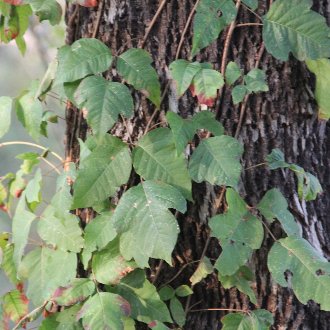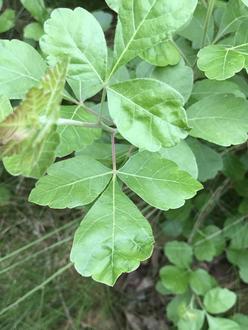Fragrant Sumac (Rhus aromatica Aiton)
↑Summary
A sprawling deciduous shrub, often growing wider than tall.
↑Range - Expand
| Legend | Color |
| Native | |
| Expanded | |
| Native or Not Present | |
| Native or Expanded |
This tentative map is based on our own research. It may have limited data on Canada and/or Mexico, and there is some subjectivity in our assignment of plants as introduced vs. expanded. Read more in this blog post.
Although this plant occurs somewhere in each of these regions, it may only occur in a small part of some or all of them.
This plant is so widely cultivated in landscaping that it occasionally escapes into the wild, even though it is not the most prolific seeder. We have marked new populations, both in the northeast and northwest, as expanded because they are all close to the native range.
↑Similar Plants
↑Uses
Used in landscaping, where it is valued for its low maximum height among shrubs, its ease of growing in dry and poor soils, its showy fruit and fall color, and the pleasant fragrance of its foliage.
↑Related Plants
Closely related to Skunkbush Sumac (Rhus trilobata), a species with a more westerly distribution. Can hybridize with this species.
↑Links & External Resources
• Fragrant Sumac | Fire Effects Information System (FEIS) (About This Site)
• Rhus aromatica (Fragrant Sumac) | Illinois Wildflowers (About This Site)
• Rhus aromatica (Fragrant Sumac) | USDA PLANTS Database (About This Site)
• Rhus aromatica | Go Botany (About This Site)
• Rhus aromatica (Fragrant Sumac) | Missouri Botanical Garden Plant Finder (About This Site)
• Fragrant Sumac | Virginia Tech Dendrology Factsheets (About This Site)
• Rhus aromatica | Biota of North America Project (BONAP) (About This Site)
• Rhus aromatica | NatureServe Explorer (About This Site)
• Rhus aromatica | Missouri Plants (About This Site)
• Fragrant Sumac | Maryland Biodiversity Project (About This Site)
• Rhus aromatica Aiton var. aromatica (Fragrant Sumac) | Digital Atlas of the Virginia Flora (About This Site)











